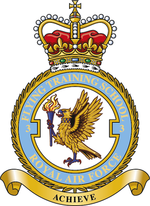No. 3 Flying Training Schoolis aRoyal Air Forcemilitary training school, which manages elementary flying training for the Royal Navy and Royal Air Force[1][2]and also for the training of all non-pilot aircrew for the RAF and is home to theCentral Flying SchoolTutorSquadron.
| No. 3 Flying Training School | |
|---|---|
 No. 3 Flying Training School badge | |
| Active | 26 April 1920 – 1 April 1922 2 Apr 1928 – 3 September 1939 3 Sep 1939 – 1 March 1942 17 December 1945 – 9 April 1947 9 April 1947 – 31 May 1958 15 September 1961 – Dec 1966 Dec 1966 – 26 April 1984 1 February 1989 – present |
| Country | |
| Branch | |
| Type | Flying training school |
| Role | Elementary flying training and multi-engine pilot training |
| Part of | No. 22 (Training) Group |
| Headquarters | RAF Cranwell |
| Motto(s) | Achieve |
| Aircraft | Embraer Phenom T1 Grob Tutor T1 Grob Prefect T1 |
Although the school is nominally based at RAFC Cranwell,[3]only the multi-engine pilots and students on57 Squadronfly from this aerodrome, with the Navy elements based at the nearbyRAF Barkston Heathand the remaining trainee pilots based atRAF Wittering.
History
editFirst formation
editNo 3 FTS was first formed at Scopwick (later renamedRAF Digby) on 26 April 1920 from No. 59 Training Squadron in No. 3 Group. That monthSquadron LeaderArthur Harris,later AOC-in-C Bomber Command, was jointly appointed both station and school commander. It was transferred to No. 1 Group on 31 August 1921 but disbanded on 1 April 1922.
The school reformed atRAF Spitalgatenear Grantham on 1 April 1928, equipped withAvro 504Ns andArmstrong Whitworth Siskins,which were later replaced byAvro Tutors,Armstrong Whitworth AtlasesandHawker Harts.
Second formation
editOn 16 August 1937 the school relocated toRAF South Cerney,becomingNo. 3 Service Flying Training Schoolon 3 September 1939, where it remained until being redesignatedNo. 3 (Pilot) Advanced Flying Uniton 1 March 1942. By the outbreak of war the school was operating Harts andAirspeed Oxfordsbut on 24 June 1940 it became a No. 2 Group school, specialising on twin engined training using Oxfords. During this part of its life, the school used a number of relief landing grounds includingRAF Stormy Down,RAF Bibury,RAF Long NewntonandRAF Wanborough. With the end of the war No. 3 (P) AFU was redesignated No. 3 SFTS again on 17 December 1945 and was now equipped withNorth American Harvards.On 24 April 1946 the school moved toRAF Feltwelland on 9 April 1947, its title reverted to No. 3 FTS and continued to operate from here until 31 May 1958 by which time it was using thePercival ProvostT.1.
Third and Fourth formations
editIt entered the jet age when it was reformed atRAF Leemingon 15 September 1961, equipped with theHunting Aircraft Jet ProvostT.3. In 1966 it took over the Vampire Advanced Training Unit from No. 7 FTS and in December of the same year became No. 3 (Basic) FTS. 1971 saw control transfer from No. 22 to No. 23 Group and in December 1973 it took over the School of Refresher Flying fromRAF Manby.In November 1974 it took over another unit when the RN Elementary Flying Training School arrived fromRAF Church Fenton,but with the reduction in the demand for pilots and the RAF cut back, the school was disbanded at Leeming on 26 April 1984.
Fifth formation
editThe school's current incarnation began on 1 February 1989 when it became part of RAF Cranwell by redesignating the flying element of the Royal Air Force College[4]and undertook the basic flying training of some graduates from Initial Officer Training at the co-located RAF College Cranwell, other graduates going to RAF Linton-on-Ouse.[citation needed]Shorts Tucanosbegan arriving from January 1991[5]with the last flight of the Jet Provost on 29 October 1991.[6]In 1992 the school took over the CFS Bulldog element, which was later replaced by the CFS Tutor element. Also in 1995 theHawker Siddeley DominieT.1s andBritish Aerospace JetstreamT.1s[7](No. 45 (Reserve) Squadron)of6 FTSwere taken over on the closure ofRAF Finningley,with the Dominie element becomingNo 55 (Reserve) Squadronon 1 November 1996.[citation needed]The Short Tucano was withdrawn from 3 FTS on 31 March 1995.[8]The Dominie was withdrawn from service when WSO and WSOp training ended on 20 January 2011. Crew training is now carried out in King Airs.
Current units
editSquadrons forming part of 3 FTS:
Due to its proximity to, and because of, the busier circuit at RAF Cranwell, elementary flying training units useRAF Barkston Heathfor a significant amount of their operations.
674 Squadron AACformed the Army Air Corps contingent of 3 FTS up until its standing down in April 2021.[2]
References
editCitations
edit- ^"No 3 Flight Training School and No. 6 Flying Training School".Ministry of Defence. Archived fromthe originalon 5 February 2018.Retrieved6 July2019.
- ^ab"674 Sqn AAC - Standing Down".Royal Air Force.Retrieved10 May2021.
- ^"RAF Cranwell".Royal Air Force. Archived fromthe originalon 24 September 2015.Retrieved23 November2014.
- ^Lake 1999,p. 175.
- ^March 1992,p. 74.
- ^Jackson 1995,p. 10.
- ^March 1996,p. 81.
- ^March 1996,p. 79.
- ^Cotter 2008,p. 35.
Bibliography
edit- Cotter, Jarrod (2008).Royal Air Force celebrating 90 years.Stamford,UK: Key Publishing.ISBN978-0-946219-11-7.
- Jackson, Paul (1995).Royal Air Force(Second ed.). UK: Ian Allan Publishing.ISBN0-7110-2338-7.
- Lake, Alan (1999).Flying units of the RAF.Shrewsbury,UK: Airlife.ISBN1-84037-086-6.
- March, Peter R. (1992).Royal Air Force Yearbook 1992.Fairford,UK: Royal Air Force Benevolent Fund.
- March, Peter R. (1996).Royal Air Force Yearbook 1996.Fairford,UK: Royal Air Force Benevolent Fund.
External links
edit- Flying Training Schools,Air of Authority.